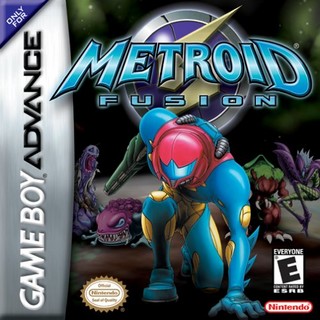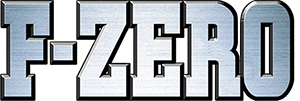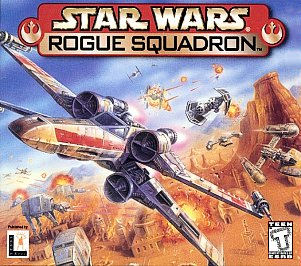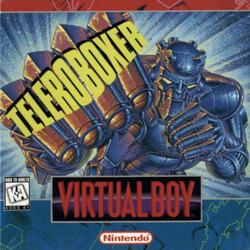
The Virtual Boy is a 32-bit tabletop portable video game console developed and manufactured by Nintendo. Released in 1995, it was marketed as the first console capable of displaying stereoscopic "3D" graphics. The player uses the console like a head-mounted display, placing the head against the eyepiece to see a red monochrome display. The games use a parallax effect to create the illusion of depth. Sales failed to meet targets, and Nintendo ceased distribution and game development in 1996, having released only 22 games for the system.
Metroid is an action-adventure game franchise created by Nintendo. The player controls the bounty hunter Samus Aran, who protects the galaxy from Space Pirates and other malevolent forces and their attempts to harness the power of the parasitic Metroid creatures.

Super Metroid is an action-adventure game developed by Nintendo and Intelligent Systems and published by Nintendo for the Super Nintendo Entertainment System in 1994. It is the third installment in the Metroid series, following the events of the Game Boy game Metroid II: Return of Samus (1991). Players control bounty hunter Samus Aran, who travels to planet Zebes to retrieve an infant Metroid creature stolen by the Space Pirate leader Ridley.

Metroid Fusion is an action-adventure game developed and published by Nintendo for the Game Boy Advance in 2002. It was developed by Nintendo Research & Development 1, which had developed the previous Metroid game, Super Metroid (1994). Players control the bounty hunter Samus Aran, who investigates a space station infected with shapeshifting parasites known as X.

Metroid: Zero Mission is an action-adventure game developed and published by Nintendo for the Game Boy Advance on February 9, 2004. It is a remake of the original Metroid (1986), and retells the story with updated visuals and gameplay.

Pokémon Snap is a 1999 first-person photography game with rail shooter style gameplay mechanics developed by HAL Laboratory and published by Nintendo for the Nintendo 64. It was first released in Japan in March 1999 and was later released in July 1999 in North America and in September 2000 for PAL regions. It is a spin-off game in the Pokémon series, being one of the first console-based games for it, and featuring many Pokémon rendered for the first time in real-time 3D. The game was re-released for the Wii's Virtual Console in December 2007, for the Wii U's Virtual Console in 2016, and for the Nintendo Switch Online + Expansion Pack in June 2022.
Nintendo Space World, formerly named Shoshinkai and Famicom Space World, was an annual video game trade show hosted by Nintendo from 1989 to 2001. Its three days of high-energy party atmosphere was the primary venue for Nintendo and its licensees to announce and demonstrate new consoles, accessories, and games. Anticipated and dissected each year with hype and exclusivity, it was a destination for the international video game press, with detailed developer interviews and technology demos.

Mario's Tennis is a 1995 sports game developed by Nintendo for the Virtual Boy video game console. The game was released at the launch of the Virtual Boy, and later as a pack-in game in North America.

Red Alarm is a 1995 shoot 'em up video game developed by T&E Soft and published by Nintendo. Released as a Virtual Boy launch game, it requires the player to pilot a space fighter and defeat the army of a malevolent artificial intelligence called KAOS. The game takes inspiration from the 1993 title Star Fox, and it is one of the few third-party titles for the Virtual Boy. Unlike most of the console's games, Red Alarm features three-dimensional (3D) polygonal graphics. However, hardware constraints limited the visuals to bare wire-frame models, similar to those of the 1980 arcade game Battlezone. Reviewers characterized Red Alarm's graphics as confusing, but certain publications praised it as one of the most enjoyable Virtual Boy titles.

Mario Clash is a video game produced by Nintendo in 1995 for the Virtual Boy. It is the first stereoscopic 3D Mario game, and a 3D reimagining of Mario Bros. Reception for the game was mixed.

F-Zero is a series of futuristic racing games published by Nintendo, developed by Nintendo EAD and other third-party companies. The first game was released for the Super Famicom in Japan in 1990. Its success prompted Nintendo to create sequels on subsequent consoles.

Star Wars Episode I: Battle for Naboo is an arcade-style action game co-developed by Factor 5 and LucasArts. It is a spiritual successor to Star Wars: Rogue Squadron released two years earlier. Despite the similarities between the two games, the development team designed a new game engine for Battle for Naboo and included land- and water-based combat in addition to aerial combat. The player can control various air, land, and water vehicles; each offers a unique armament arrangement, as well as varying degrees of speed and maneuverability. Bonus power-ups that improve these crafts' weapons or durability are hidden in different levels throughout the game. The player's performance is checked against four medal benchmarks after the completion of each level. Acquiring these medals promotes the player's rank and helps unlock hidden content.

Virtual Boy Wario Land is a platforming video game developed and published by Nintendo for the Virtual Boy game system in 1995. It stars Wario, a treasure hunter who must find treasure and fight enemies to progress. Wario can jump and charge with his shoulder as basic techniques, and equip special hats to gain things such as fire breathing and bull horns. He has the ability to enter the background at certain points, making use of the console's stereoscopic 3D effect. It was developed by Nintendo R&D1, containing a large portion of its staff, and features the red-and-black color scheme that is standard for Virtual Boy releases.

Galactic Pinball is a pinball video game for Nintendo's Virtual Boy game console. The game was released on July 21, 1995 in Japan and on August 14, 1995 in the United States. It is set in the Milky Way galaxy, and has players maneuvering a puck around one of four pinball tables available in the game. The Virtual Boy's standard red-and-black color scheme resulted in criticism of this and other games on the platform for causing nausea, headaches, and eye strain. It uses parallax, which allows the game to display three-dimensional effects. It has received a mixed reception; it was praised for its authenticity, while reception to its physics and controls were mixed. It has received criticism for its lack of ambition and originality.

Star Wars: Rogue Squadron is an arcade-style flight action game co-developed by Factor 5 and LucasArts. The first of three games in the Rogue Squadron series, it was published by LucasArts and Nintendo and released for Microsoft Windows and Nintendo 64 in December 1998. The game's story was influenced by the Star Wars: X-wing – Rogue Squadron comics and is set in the fictional Star Wars galaxy, taking place primarily between events in the films Star Wars and The Empire Strikes Back. The player controls Luke Skywalker, commander of the elite X-wing pilots known as Rogue Squadron. As the game progresses, Skywalker and Rogue Squadron fight the Galactic Empire in 16 missions across various planets.

The Mysterious Murasame Castle is an action-adventure video game developed by Nintendo and Human Entertainment and published by Nintendo for the Family Computer Disk System. It was released exclusively in Japan on April 14, 1986. The game was one of the early games released for the system, and the second original game after The Legend of Zelda. The game was released outside Japan for the first time on the Nintendo 3DS Virtual Console in Europe and Australia in May 2014 and in North America in August 2014. It was added to the Nintendo Switch Online service on October 31, 2023.

Star Fox 64 3D is a 3D rail shooter video game co-developed by Nintendo EAD and Q-Games and published by Nintendo for the Nintendo 3DS. It is a remake of the 1997 video game Star Fox 64 for the Nintendo 64. It was released on July 14, 2011 in Japan, followed by other markets in September.

Brain Age: Concentration Training, known in Europe and Australia as Dr Kawashima's Devilish Brain Training: Can you stay focused?, is an educational puzzle video game developed and published by Nintendo. It is the fourth major entry in the Brain Age series and the first made specifically for the Nintendo 3DS. It was released in Japan on July 28, 2012, in North America on February 10, 2013, and in South Korea on September 5, 2013. It later came to Europe on July 28, 2017, and Australia on July 29, 2017, five years apart from the initial release. Dr. Kawashima presents the game's purpose as being to counter prevalent subpar concentration skills onset by social media and other aspects of modern life.
















